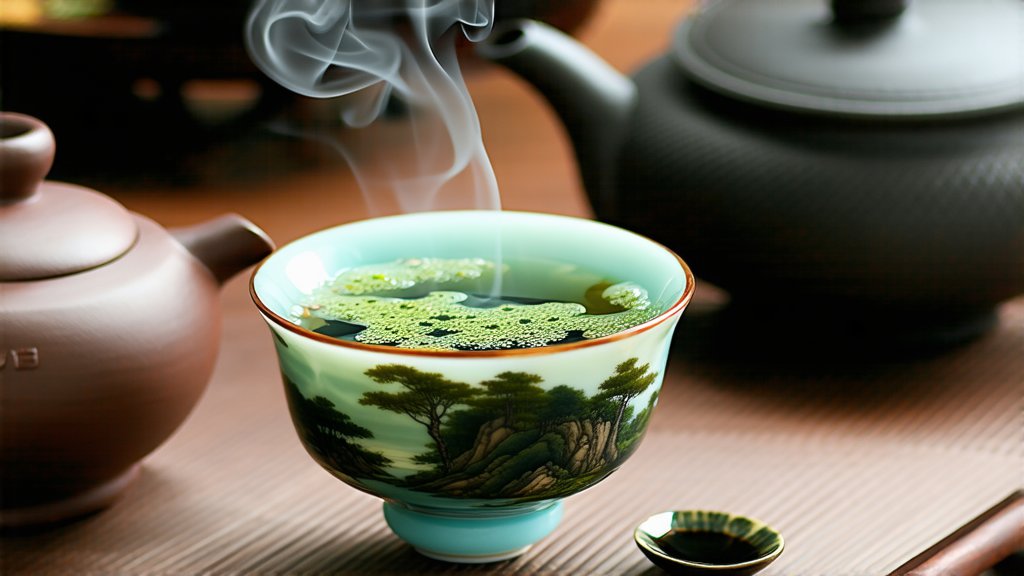
Tieguanyin, often referred to as the "Iron Goddess of Mercy" or "Beautiful Chrysanthemum," is one of the most revered varieties within the vast spectrum of Chinese oolong teas. This exquisite tea hails from the lush mountains of Anxi County in Fujian Province, China, where it has been cultivated for over 300 years. Its name, which translates to "Iron Buddha," is derived from a legend involving a poor scholar who found refuge in a temple and discovered a magical tea plant that cured his ailments. The tale intertwines the spiritual and the earthly, much like the tea itself, which bridges tradition and modernity.
Historical Background
The origins of Tieguanyin can be traced back to the early Qing Dynasty (1644-1912). According to local lore, a Buddhist monk named Wang discovered a unique tea bush near the temple he resided in. He propagated cuttings from this bush, which eventually spread throughout the region. By the mid-18th century, Tieguanyin had become a highly sought-after tea, not just for its medicinal properties but also for its extraordinary flavor profile. It gained immense popularity among the literati and became a symbol of refinement and sophistication.
In the 19th century, Tieguanyin made its way to the international stage when Chinese laborers brought it to Southeast Asia and Europe. Today, it continues to captivate tea enthusiasts worldwide with its complex aroma and taste.
Varieties of Tieguanyin
Tieguanyin encompasses several sub-varieties, each with its own distinct characteristics. The two primary types are:
-
Anxi Tieguanyin: This is the original and most prestigious variety, grown exclusively in Anxi County. It is known for its floral fragrance and smooth, creamy texture. The leaves are typically rolled into tight pellets, resembling green beans.
-
Non-Anxi Tieguanyin: These are grown outside Anxi County but still adhere to traditional cultivation and processing methods. While they may lack the precise terroir of Anxi Tieguanyin, they offer a more affordable alternative without compromising too much on quality.
Crafting the Perfect Cup
The artistry involved in producing Tieguanyin is a meticulous process that combines both science and tradition. Here's an overview of the key steps:
-
Cultivation: The tea bushes are typically grown on steep, rocky slopes at elevations ranging from 300 to 1000 meters above sea level. This environment contributes to the tea's unique mineral content and flavor complexity.
-
Harvesting: Leaves are plucked with great care, usually during the spring and autumn seasons when the climate is optimal for growth. Only the tender shoots and leaves are selected to ensure the highest quality.
-
Withering: Freshly picked leaves are spread out in bamboo baskets or mats to wilt under the sun or indoors. This process reduces moisture content and initiates enzymatic activity.
-
Tossing and Turning: After withering, the leaves undergo repeated tossing and turning, either manually or using specialized machines. This step helps to further reduce moisture and promote even oxidation.
-
Fixation: The leaves are briefly exposed to high heat (usually around 200°C) to halt oxidation and preserve their greenish hue. This is done in large woks or drums.
-
Rolling: The fixed leaves are then rolled into their characteristic tight pellet shape. This not only enhances aesthetic appeal but also allows for better extraction during brewing.
-
Roasting: Depending on the desired flavor profile, the rolled leaves may undergo additional roasting. Light roasts bring out floral notes, while darker roasts impart a richer, more toasty character.
-
Sorting and Packaging: Finally, the tea is sorted by grade and packaged carefully to maintain freshness until it reaches the consumer.
A Symphony of Sensory Experience
Tasting Tieguanyin is akin to embarking on a sensory journey. Here’s how you can fully appreciate this exceptional tea:
-
Warming the Teapot: Begin by rinsing your teapot and cups with hot water to warm them up. This ensures that the tea maintains its optimal temperature during brewing.
-
Measuring: Use approximately 5 grams of Tieguanyin per 150ml of water. Place the tea leaves into a Yixing clay pot or a Gaiwan, if available, for the best experience.
-
First Infusion: Pour hot water (around 95°C) over the leaves and let it sit for about 15 seconds before discarding this initial brew. This serves to "wake up" the leaves and remove any impurities.
-
Subsequent Infusions: For subsequent infusions, gradually increase the steeping time by a few seconds each time. Typical sessions involve multiple infusions, each revealing different aspects of the tea's flavor profile.
-
Observing: Watch as the tightly rolled pellets unfurl gracefully in the water, releasing their vibrant color and aroma. The liquor should be a bright, golden-green hue.
-
Smelling: Before taking your first sip, take a moment to inhale the fragrant steam rising from the cup. Notes of orchids, chrysanthemums, and honey are common descriptors for Tieguanyin's aroma.
-
Sipping: Take small sips, allowing the tea to roll over your palate and savor its multifaceted flavors. You may detect floral sweetness, creamy texture, and a lingering aftertaste that hints at minerals and spices.
-
Appreciation: Reflect on the harmony between the tea's aroma, taste, and mouthfeel. Each infusion tells a story, evolving from light and floral to deeper, more complex notes as the session progresses.
Conclusion
Tieguanyin stands as a testament to the artistry and dedication inherent in Chinese tea culture. From its storied past to its present-day prominence on the global stage, this remarkable oolong tea continues to enchant tea lovers with its intricate flavors and aromatic allure. Whether enjoyed in solitude or shared among friends, a cup of Tieguanyin offers a moment of tranquility and a profound connection to centuries-old traditions. As you delve into the world of Tieguanyin, explore its nuances, embrace its history, and allow yourself to be transported by its timeless elegance.